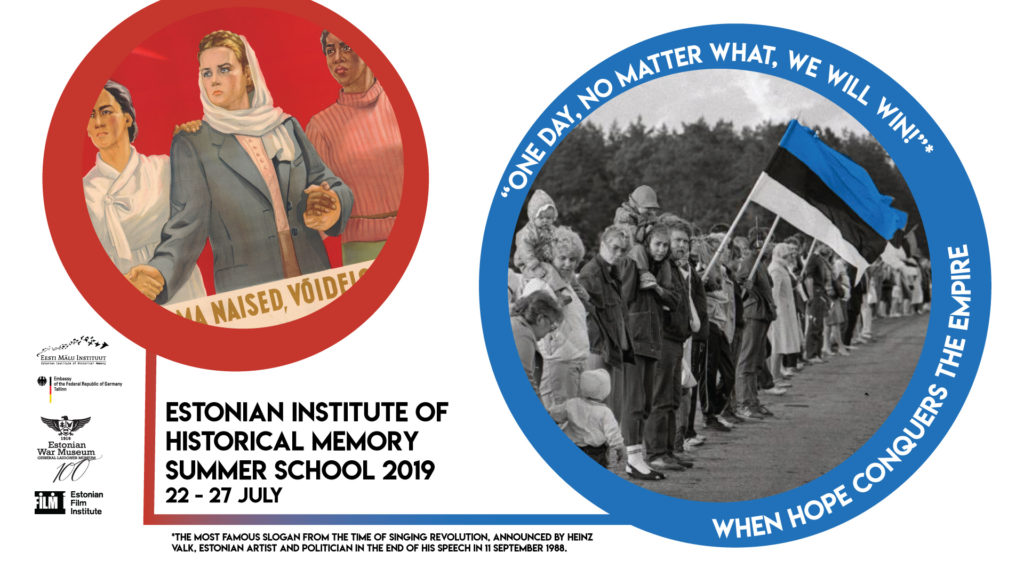“One day, no matter what, we will win!”[1]
When hope conquers the empire
Estonian Institute of Historical Memory Summer school 2019[2]

Dear historians, history teachers and graduate students of history!
After the Second World War, the Cold War broke out and a bipolar world emerged, which was divided into the communist Eastern Bloc and the democratic Western world, each with their own allies. The Iron Curtain descended on the dividing line separating them in Europe. Since the 1960s, it was symbolised by the Berlin Wall, which split not only Germany and its capital, but even families.
Every empire wants to last forever and to be omnipotent, but no empire is. Neither was the Soviet Union. Sixty-nine years is less than a human lifetime, but it is a very long time if we think of the crimes against humanity and violations of human rights committed during that period. We dwelt on those themes at last year’s summer school. This time we will concentrate on the building of a free society after the collapse of the Eastern Bloc, using Estonia as an example.
On 12 June 1987, US President Ronald Reagan said to Mikhail Gorbachev, the Chief Secretary of the Soviet Union, in his speech at the Brandenburg Gate in West Berlin:
We welcome change and openness; for we believe that freedom and security go together, that the advance of human liberty can only strengthen the cause of world peace. There is one sign the Soviets can make that would be unmistakable, that would advance dramatically the cause of freedom and peace. General Secretary Gorbachev, if you seek peace, if you seek prosperity for the Soviet Union and Eastern Europe, if you seek liberalization, come here to this gate. Mr. Gorbachev, open this gate. Mr. Gorbachev…Mr. Gorbachev, tear down this wall!
This speech had a much greater meaning than its words for the countries that were occupied by the Soviet Union. It was a ray of hope for liberation from the yoke of the Soviet Union and gave impetus to the desire for freedom, which could no longer be slowed down.
On 23 August 1987, the first public meeting was held in Estonia, at which the public disclosure of the secret protocol of the Hitler-Stalin pact, the liquidation of its consequences, and the release of political prisoners were demanded. Nearly 7,000 people attended the meeting, and quite a few of its organisers fell victim to KGB repressions still at that time.
Night-time mass gatherings started taking place at the Song Festival Grounds in 1988. Patriotic songs, including the Estonian national anthem, were sung at these gatherings, and the blue, black and white national flag was brought out in public. Just a few years prior to that, such an act would have been punished by the authorities. New songs were written, which immediately became exceedingly popular. The Baltic Chain, a joint demonstration carried out by the inhabitants of the three Baltic states, was held on 23 August 1989. Nearly two million Estonians, Latvians and Lithuanians formed an unbroken human chain over 600 km long, demanding the return of their freedom, the deprivation of which from them had been decided by the secret protocol of the Hitler-Stalin pact on 23 August 1939.
This was a time when hopes sprang up anew and were fulfilled. When a coup was carried out in Moscow in August, the Supreme Soviet of the Republic of Estonia voted on 20 August 1991 at 23:03 in favour of restoring Estonia’s national independence. On the following day, the Republic of Latvia declared itself independent once again. The Republic of Lithuania had already declared itself independent on 11 March 1990, but foreign countries and the Soviet Union recognised this only after the August coup.
The flag of the Soviet Union that flew over the Kremlin was lowered for the last time on 25 December at 19:32.
Come and take part in the great story of the liberation of little Estonia. The four-day long programme offers interesting lectures and discussion groups by activists and freedom fighters from that time. These are living stories, personal recollections and emotions from people who were the contemporaries, participants and leaders of those events. The programme includes a selection of films that bring before our eyes the atmosphere of that time that was filled with hopes. Additionally, we offer artistic creative work in order to step out of everyday routine and to learn history in an entirely new way.
The working language of the summer school is English.
View the programme and apply to the summer school here. Applications are accepted until 3 June 2019.
Organisers:
The summer school is organised by the Estonian Institute of Historical Memory with the support of the Embassy of the Federal Republic of Germany in Estonia.

Programme:
The highly informative and exciting programme includes presentations on the fight for freedom by people who were actively involved in the historical events, engaging hands-onworkshops on how to read and create propaganda posters, historical site visits and thematic film screenings. Discussions take place throughout the programme to allow exchange of knowledge and perspectives, and solidify the acquired knowledge. Detailed information about the programme will be sent to the applicants during the application process. All participants will receive a certificate after completing the summer school.
[1] The most famous slogan from the time of the Singing Revolution, proclaimed by Heinz Valk, Estonian artist and politician, at the end of his speech on 11 September 1988.
[2] Estonian Institute of Historical Memory is covering all the costs of the summer school to the participants, except travel costs. Please note participants will be accommodated in a 3+ star hotel in twin rooms by gender.
Apply here:


